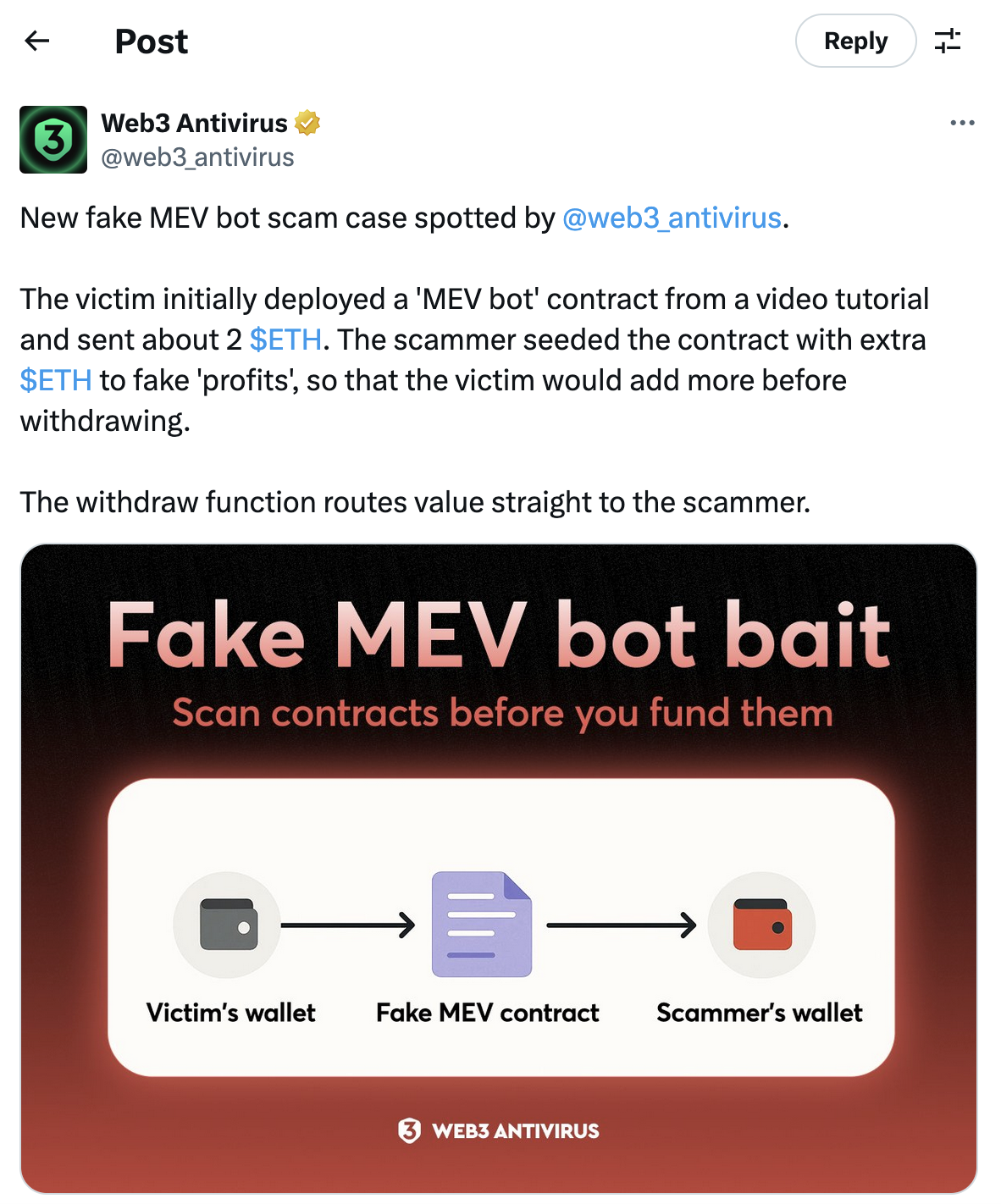Recently, the Web3 security organization @web3_antivirus issued a critical security alert, exposing a new type of cryptocurrency scam. The scheme uses a so-called "MEV bot" (Maximal Extractable Value bot) as a lure, tricking users into deploying a malicious smart contract via carefully crafted video tutorials to ultimately steal their digital assets. This article will break down how the scam works and provide essential security advice to help you protect your funds.

The "High-Yield" Trap: How the Fake MEV Bot Scam Works
This scam preys on users' desire for easy money and their lack of familiarity with smart contract technology. Its deceptive nature unfolds in several stages:
-
The Bait: A Smart Contract Disguised as a Profit Machine
-
Scammers create and upload video tutorials on platforms like YouTube, claiming to show you how to deploy a "smart contract" that automatically performs MEV arbitrage. A victim, eager to profit, deploys the contract and sends an initial investment, such as the 2 ETH mentioned in the report.
-
The Illusion: Faking Profits to Lure More Funds
-
This is the most cunning part of the scam. The scammer pre-funds the malicious contract with extra ETH to create the illusion of quick profits. When the victim checks the contract's balance, they see not just their initial investment but a supposed "gain," which strongly builds their trust and greed.
-
The Harvest: The Withdrawal Function is a Money Transfer
-
The scam's true nature is revealed when the victim, enticed by the fake profits, invests more funds and then tries to withdraw their principal and "earnings." The malicious code is hidden in the contract's withdraw function. Instead of returning the funds to the victim, the code is designed to transfer all assets from the contract directly to the scammer's wallet address.
This entire operation is a well-orchestrated scheme that leverages human greed and trust, leading victims step-by-step into a carefully designed trap.
How to Protect Your Crypto: Essential Security Advice
To avoid becoming the next victim, all cryptocurrency users should follow these crucial security guidelines. They apply not only to MEV bot scams but also to other potential threats in the Web3 space.
-
Maintain a High Level of Vigilance
-
Treat any video, website, or social media post that promises "automated high returns" or "free" arbitrage tools as a potential scam. Never trust smart contract code or applications from unofficial or unverified sources.
-
Scrutinize Smart Contract Code
-
Before interacting with any smart contract that requires you to deposit funds, you must carefully review its code. If you lack the technical skills to audit the code, seek help from a professional auditing firm or a security expert. Pay special attention to the logic of the withdraw or any fund transfer functions to ensure they are transparent and secure.
-
Use Transaction Simulation Tools
-
Before signing any transaction, use a simulation feature available in wallets like MetaMask or other professional security tools. These tools show you the final state of a transaction after it's executed. If you see that your funds will be transferred to an unknown address, stop the process immediately.
-
Start with Small Amounts
-
Before investing a significant amount of money, always test with a minimal amount first. If a supposed "bot" or app demands a large investment to "activate" or show a "profit," it's a major red flag.
Conclusion: In Web3, Prevention Is the Best Cure
This incident is a stark reminder that the decentralized and open nature of the Web3 world comes with significant security risks. Unlike traditional finance, a smart contract's code is law. Once deployed, malicious code can be permanently embedded. Scammers are constantly evolving their tactics.
Protecting your digital assets requires not only technical safeguards but also a critical mindset and a high degree of skepticism. Remember, in the world of blockchain, there's no such thing as a free lunch.











